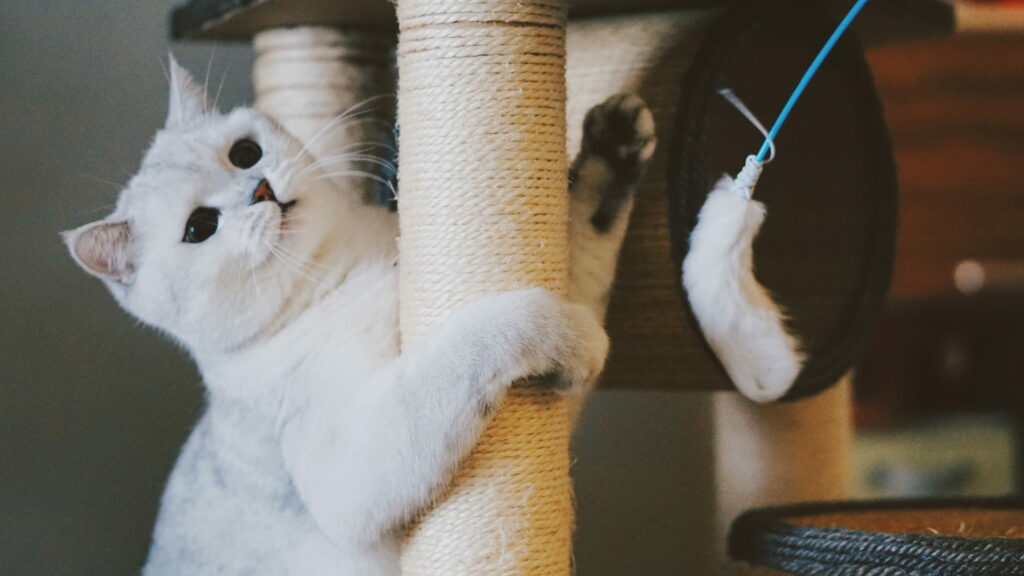Cats are wondrous animals, and most cat guardians would agree that they make the most amazing companions. Usually our cats are easy housemates, but sometimes, some natural behaviours could cause tension if its not expressed in the correct context. Take scratching, for example. It is a perfectly normal cat behaviour and one that your cat probably enjoys thoroughly. You may have seen her test all sorts of surfaces – your table legs, the potted tree near the front door, the couch, the carpet, and the curtains – for its suitability as a scratching post for her. And while the tree might seem ok, the couch might not love the attention as much.
Having a suitable scratching post is a great way to redirect this natural behaviour onto something appropriate, allowing your cat to carry out those natural instincts in a way that won’t ruin your furniture.
But did you know that your cat doesn’t automatically know what the scratching post is for? This is where a little bit of work from you now pays off big time in the long run.
What to get?
- Vertical posts must be sturdy and tall enough for the cat to stand up and stretch to her full body length. Some cats prefer horizontal posts. Try both types to find out what your cat prefers or offer one of each if you can.
- Make sure the post is covered in something that your cat can get her nails into, like carpet or sisal. If you choose sisal, remember to replace it if it becomes worn to prevent loose strands ending up in eyes!
- A sturdy post that does not wobble when your cat pulls on it with her full weight. If it wobbles, she won’t use it and will focus her attention on your couch instead.
Here are some easy-to-follow steps for teaching your cat to scratch on her new scratching post:
Firstly, the scratching posts should be located in areas of your home where your cat spends time, not hidden away. Though we humans may have preferences for where we’d like the cat scratching posts to be in our home (usually in corners and out-of-the-way places) these aren’t always the best spots in the eyes of our feline friends. Cats often scratch when they wake up from a nap, or in high traffic areas that are shared with other cats. Remember, providing your cat with multiple scratching posts in different areas of your home increases the likelihood that your furniture and carpeting will be left alone.
If you notice her scratching in a particular area, like the couch, temporarily put the scratching post in front of the couch and slowly move it to where you want it once she has learned to scratch on the post.
The first step in teaching your cat to scratch the scratching post, is to attract your cat to the post. You can do this using catnip.
Rub catnip around the base, or hang catnip toys from the platform, depending on your scratching post. If you see you cat scratching on the post, reward with attention or treats.
Spend time near the scratching post encouraging your cat to play with it, and incorporate it into your playtime with her. Always reward appropriate scratching on the post with lots of attention and treats. You can even scratch on the post yourself, using your fingers. If she investigates and joins you, make a big fuss and tell her how smart she is.
If you see your cat scratching somewhere else, simply give her a gentle signal like “uh-uh” and move her to the scratching post. Reward her once there and if she scratches on the post, then remember to give treats and lots of praise.
One thing that usually does NOT work when introducing a cat to a new scratching post is to grab her paws, place them on the post, and show her how to scratch. Manhandling their paws is usually a no-no in the eyes of most cats and will likely result in avoidance of the scratching post.
Negative training methods usually backfire.
Many online training methods seek to associate negative consequences with unwanted behaviour, such as spraying water in a cat’s face when they scratch the couch. We want to emphasize that these aversive techniques usually backfire in significant ways the owner doesn’t foresee, and it is likely to damage your relationship with your cat significantly. Many cats will become stressed by such occurrences, which may result in the cat spraying, defecating outside the sandbox or on personal items, or scratching even more inappropriately as a way of coping with this stressful (and, in the cat’s eyes, completely random) punishment.
We urge owners to focus on positive reinforcement training techniques by rewarding the behaviour you want to see from your cat (her using the scratching post in this case), and by providing her with safe alternatives to use, sparing both your furniture and your relationship with your cat!
With a little bit of thought, time, and praise, your cat will be ignoring your furniture and carpeting in favour of her new scratching posts.





